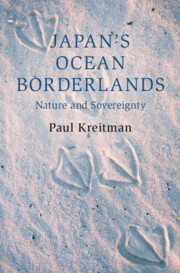Book contents
- Japan’s Ocean Borderlands
- Cambridge Oceanic Histories
- Japan’s Ocean Borderlands
- Copyright page
- Contents
- Maps
- Figures
- Acknowledgements
- Naming Conventions
- Maps
- Introduction
- 1 Bonins of Contention
- 2 The Race to Marcus Island
- 3 Bird and Sovereignty Conservation in the Northwest Hawaiian Islands, 1898–1911
- 4 Sand Dunes and Soldiers
- 5 Disaster
- 6 Resurrecting the Torishima Albatross
- 7 The Nature of the Senkaku Islands
- Epilogue
- Appendix Japanese Islands Abandoned, 1868–2013
- Select Bibliography
- Index
6 - Resurrecting the Torishima Albatross
Wild Birds and Sovereignty in Post-War Japan
Published online by Cambridge University Press: 06 July 2023
- Japan’s Ocean Borderlands
- Cambridge Oceanic Histories
- Japan’s Ocean Borderlands
- Copyright page
- Contents
- Maps
- Figures
- Acknowledgements
- Naming Conventions
- Maps
- Introduction
- 1 Bonins of Contention
- 2 The Race to Marcus Island
- 3 Bird and Sovereignty Conservation in the Northwest Hawaiian Islands, 1898–1911
- 4 Sand Dunes and Soldiers
- 5 Disaster
- 6 Resurrecting the Torishima Albatross
- 7 The Nature of the Senkaku Islands
- Epilogue
- Appendix Japanese Islands Abandoned, 1868–2013
- Select Bibliography
- Index
Summary
Though Anglo writers may have romanticised albatrosses, Japanese attitudes toward the birds were brusquely unsentimental. Indeed, the Japanese name for Steller’s albatross translates simply as ‘stupid bird’, and by the eve of World War II Japanese bird-hunters had pushed the species to the brink of extinction. But in the post-war period Japanese attitudes toward albatrosses changed utterly. The birds became the object of a sustained conservation campaign: in 1958 their nesting grounds on Torishima were designated a ‘natural monument’ of the nation, and Japanese ornithogists successfully lobbied to have the species added to the IUCN’s embryonic biodiversity database.
Conservationists have generally framed this sea-change in atitudes toward albatrosses as part of a trajectory of national moral renewal. But this framing omits the class politics that often characterise wildlife conservation in practice, as well as the post-colonial context distinctive to post-war Japan. Bird conservation provided a way for Japan’s overwhelmingly aristocratic ornithologists to carve out a new public role for themselves in post-war society. They did so by consciously fashioning the fall and rise of Torishima’s albatrosses as an allegory for mid-twentieth-century international relations, exploiting ambient anxiety about Japan’s compromised sovereignty following defeat in World War II.
Keywords
- Type
- Chapter
- Information
- Japan's Ocean BorderlandsNature and Sovereignty, pp. 167 - 200Publisher: Cambridge University PressPrint publication year: 2023

